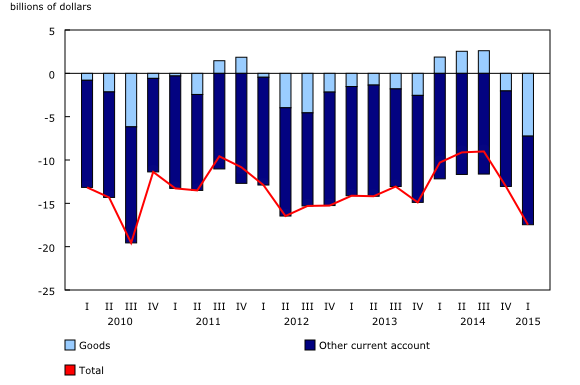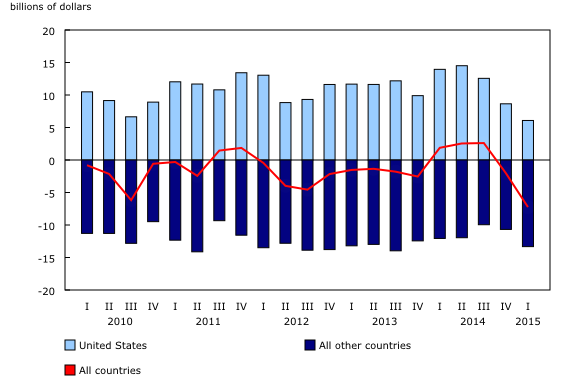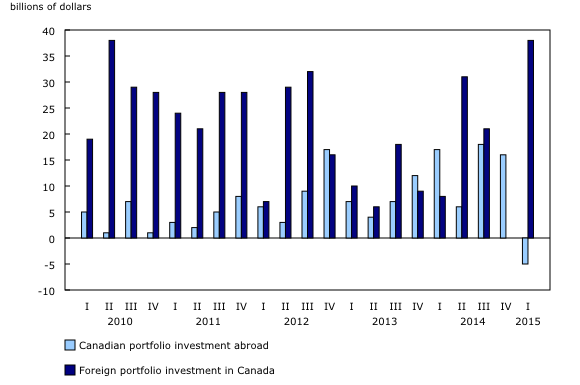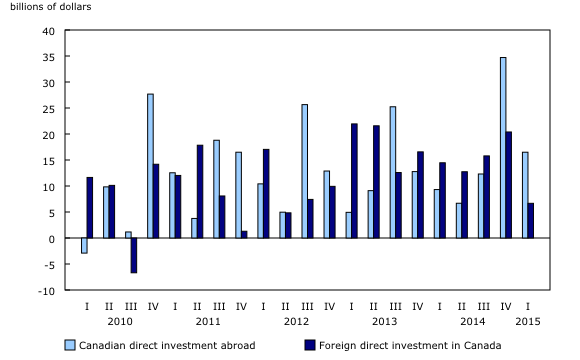Canada's balance of international payments, first quarter 2015
Archived Content
Information identified as archived is provided for reference, research or recordkeeping purposes. It is not subject to the Government of Canada Web Standards and has not been altered or updated since it was archived. Please "contact us" to request a format other than those available.
Released: 2015-05-28
Canada's current account deficit (on a seasonally adjusted basis) expanded again in the first quarter, up $4.4 billion to $17.5 billion, after narrowing in the first three quarters of 2014. This change in direction over the last two quarters was mainly due to trade in goods, especially energy products.
In the financial account (unadjusted for seasonal variation), Canadian investments abroad slowed in the first quarter, while foreign investment in Canada reached $62.1 billion. Foreign investment in Canadian bonds was the largest contributor to the net inflow of funds to the economy.
Current account
Trade in goods deficit widens further
The trade in goods deficit expanded by $5.2 billion to a record $7.2 billion in the first quarter. This change reflected a gradual deterioration of the goods balance in each month of the quarter. This followed a return to a deficit on goods trade of $2.0 billion in the fourth quarter of 2014.
Overall exports of goods declined $4.1 billion to $128.0 billion in the first quarter. Energy product values were down $5.9 billion despite higher volumes (+3.9%). This reduction was concentrated in crude petroleum. Crude prices fell 32% in the quarter, reaching their lowest levels since the first quarter of 2009. Metal and non-metallic mineral products also declined in the first quarter (-$0.8 billion) as export volumes of precious metals shrank.
Moderating the decline in energy exports were increases in several goods categories over the quarter. Exports of farm, fishing and intermediate food products were up by $0.6 billion, mostly on higher volumes of wheat. Exports of consumer goods rose $0.5 billion on higher prices. Forestry products, electronic and electrical equipment and parts as well as aircraft and other transportation equipment and parts exported each increased by $0.4 billion in the quarter on higher volumes and prices.
Total imports of goods advanced $1.1 billion to $135.3 billion. The largest gains were in electronic and electrical equipment and parts, up $1.1 billion on larger volumes of communications and audio and video equipment. Consumer goods increased by $1.0 billion while industrial machinery, equipment and parts increased $0.7 billion, both led by higher prices. On the other hand, imports of energy products were down by $1.7 billion, reflecting reduced prices but higher volumes.
Weakness in goods trade widespread geographically
On a geographical basis, the goods balance deteriorated for both the United States and non-US countries in the first quarter. The goods surplus with the United States narrowed by $2.6 billion to $6.1 billion. The value of exports to the United States decreased for a second straight quarter, down $3.7 billion following a $2.2 billion decline in the fourth quarter of 2014. Moderating this decrease were lower imports from the United States. Declines for both exports and imports were led by crude petroleum.
Goods trade with non-US countries produced a similar change in the balance. The deficit widened by $2.7 billion to $13.3 billion, mainly on higher imports. The deficit with China expanded by $1.1 billion to a record $5.4 billion. Goods balances with Japan, Italy, Netherlands, Switzerland and Taiwan all deteriorated during the first quarter. However, goods balances with United Kingdom and Singapore improved.
Deficit on trade in services largely unchanged
The deficit on international trade in services narrowed by $0.1 billion to $5.6 billion in the first quarter. In the travel account, Canadians reduced their spending in the United States and overseas while expenditures by non-residents in Canada were unchanged. As a result, the travel deficit shrank by $0.2 billion. The surplus on trade in commercial services edged down, as imports advanced by more than exports. The deficit on transportation services was up slightly in the quarter.
Investment income deficit narrows
The investment income deficit was reduced by $0.7 billion to $3.7 billion in the first quarter, as receipts were up by more than payments. Income received on foreign investments by both Canadian direct and portfolio investors continued to advance. On the payments side, profits earned in Canada by foreign direct investors edged down. However, payments on portfolio investment liabilities increased by $0.3 billion, led by higher interest payments on foreign currency denominated Canadian corporate bonds. The Canadian dollar depreciated against its US counterpart by 8.5% in the first quarter.
Financial account
Foreign investment in Canadian securities increases significantly
Foreign investors increased their holdings of Canadian securities by $37.6 billion in the first quarter, following a marginal investment in the previous quarter. This activity was led by record acquisitions of Canadian bonds by foreign investors.
Foreign investment in Canadian bonds amounted to $41.4 billion, mainly in new issues of Canadian private corporate bonds denominated in foreign currencies. Foreign purchases of federal government bonds on the secondary market also contributed to the inflows. The level of activity in the first quarter contrasted with the pattern observed in 2013 and 2014, when foreign investment in Canadian bonds slowed after four years of sustained and large inflows in government bonds.
At the same time, non-resident investors withdrew $13.3 billion of funds from the Canadian money market in the first quarter against the backdrop of a relatively significant decline in Canadian short-term interest rates. This decline was the largest foreign divestment in Canadian paper on record. More than half of this reduction was in the form of federal Treasury bills, mainly retirements.
Non-residents added $9.5 billion of Canadian equities to their holdings in the first quarter, following a rare divestment in the fourth quarter. Canadian stock prices rose by 1.8% in the first quarter. Foreign investors have acquired Canadian shares in seven of the last eight quarters, with acquisitions totalling $63.4 billion.
Canadian holdings of foreign securities decline
Canadian investors sold $5.3 billion of foreign securities in the first quarter, the first quarterly divestment in more than five years. Most of this activity was recorded in January and was concentrated in foreign shares.
Canadian holdings of foreign equities were down by $4.0 billion on sales of both US and non-US foreign shares. US stock prices edged down in the first quarter. At the same time, Canadian holdings of foreign debt securities declined by $1.4 billion, led by a divestment in non-US foreign bonds.
Outward and inward direct investment slow
Transactions in Canadian direct investment abroad slowed to $16.5 billion in the first quarter, following a record investment in the fourth quarter. Outflows related to mergers and acquisitions were down to $5.2 billion compared with $25.0 billion in the fourth quarter. On an industry basis, Canadian direct investment abroad was focused in the finance and insurance industry.
Foreign direct investment inflows to Canada were $6.7 billion, the lowest such activity since the second quarter of 2012. Earnings reinvested in Canadian subsidiaries by foreign direct investors, mainly from the United States, accounted for the bulk of this activity. Mergers and acquisitions transactions generated a reduction in foreign direct investment in Canada, as non-resident direct investors sold some of their assets back to Canadian investors in the quarter.
Note to readers
The balance of international payments covers all economic transactions between Canadian residents and non-residents in three accounts: the current account, the capital account and the financial account.
The current account covers transactions in goods, services, compensation of employees, investment income and secondary income (current transfers).
The current account data in this release are seasonally adjusted. For more information on seasonal adjustment, see Seasonally adjusted data – Frequently asked questions.
The capital account covers capital transfers and transactions in non-produced non-financial assets.
The financial account covers transactions in financial assets and liabilities.
In principle, a net lending (+) / net borrowing (-) derived from the sum of the current and capital accounts corresponds to a net lending (+) / net borrowing (-) derived from the financial account. In practice, as data are compiled from multiple sources, this is rarely the case and gives rise to measurement error. The discrepancy (net errors and omissions) is the unobserved net inflow or outflow.
For more information about the balance of payments, consult the "Frequently asked questions" section in the System of macroeconomic accounts module of our website. The module also presents the most recent balance of payments statistics.
The balance of international payments data for the second quarter will be released on August 31.
Contact information
For more information, contact us (toll-free 1-800-263-1136; 514-283-8300; infostats@statcan.gc.ca).
To enquire about the concepts, methods or data quality of this release, contact Denis Caron (613-808-2278; denis.caron@statcan.gc.ca), International Accounts and Trade Division.
- Date modified:





